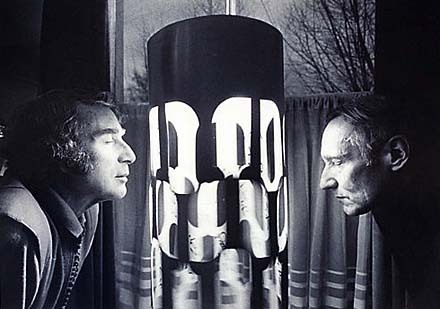 |
| Brion Gysin and William S. Burroughs flooding their brains with alpha waves via Ian Sommerville's Dreamachine (read more about it here). |
This is the start of a seven-class unit focused on a series of interrelated techniques and aesthetic ideologies that will find us leapfrogging from fragmentation and collage through iterative (or repetitive) and juxtapositional processes and into composition via transcription (which itself takes several forms). This time will also serve as a primer for your midterm audio collages, which will reflect some manner of the techniques that we'll be discussing over that span. Today we begin with the cut-up.
While the cut-up is often attributed to Beat novelist William S. Burroughs and artist and writer Brion Gysin during the 1950s, its true origins lie in the aesthetic methodologies of Tristan Tzara, formulated in the 1920s:
To make a Dadaist poem:
- Take a newspaper.
- Take a pair of scissors.
- Choose an article as long as you are planning to make your poem.
- Cut out the article.
- Then cut out each of the words that make up this article and put them in a bag.
- Shake it gently.
- Then take out the scraps one after the other in the order in which they left the bag.
- Copy conscientiously.
- The poem will be like you.
- And here are you a writer, infinitely original and endowed with a sensibility that is charming though beyond the understanding of the vulgar.
Still, Burroughs and Gysin did a great deal to further refine its procedures, including moving beyond text-based methods to work with both audiotape and film (and the repetitive nature of cut-ups would also greatly influence Gysin's painting). Here's a brief video clip of Burroughs describing the discovery and development of the technique:
Burroughs would use the technique in Naked Lunch as well as the three novels of his Nova Trilogy: The Soft Machine, The Ticket That Exploded, and Nova Express, and collaborations between the two would be published in the late 1970s as The Third Mind. These excerpts from Naked Lunch's "Atrophied Preface" give a sense of how well the cut-up meshed with Burroughs' aesthetic worldview:
Why all this waste paper getting The People from one place to another? Perhaps to spare the Reader stress of sudden space shifts and keep him Gentle? And so a ticket is bought, a taxi called, a plane boarded. We are allowed a glimpse into the warm peach-lined cave as She (the airline hostess, of course) leans over us to murmur of chewing gum, dramamine, even nembutal.
"Talk paregoric, Sweet Thing, and I will hear."
I am not American Express.... If one of my people is seen in New York walking around in citizen clothes and next sentence Timbuktu putting down lad talk on a gazelle-eyed youth, we may assume that he (the party non-resident of Timbuktu) transported himself there by the usual methods of communication... [...]
There is only one thing a writer can write about: what is in front of his senses at the moment of writing... I am a recording instrument... I do not presume to impose “story” “plot” “continuity”... Insofar as I succeed in Direct recording of certain areas of psychic process I may have limited function... I am not an entertainer...
We'll read a variety of texts by these two authors for today's class:
William S. Burroughs (from Word Virus: the William S. Burroughs Reader, ed. James Grauerholz and Ira Silverberg) [PDF]
- Atrophied Preface (Wouldn't You?)
- Quick . . .
- Operation Rewrite
- The Invisible Generation
- The Exterminator
- The Future of the Novel
- Notes on These Pages
- Technical Deposition of the Virus Power
Brion Gysin (from Back in No Time: the Brion Gysin Reader, ed. Jason Weiss) [PDF]
- First Cut-Ups
- Minutes to Go
- CUT ME UP * BRION GYSIN ...
- Permutation Poems (intro and poems)
- About the Cut-Ups
On UbuWeb you'll find a complete set of the cut-up films made by Burroughs, Gysin, and Antony Balch in the 1960s and 70s (perhaps look at "Towers Open Fire" and "The Cut-Ups"). You can also listen to a variety of Gysin's audio cut-ups here.

No comments:
Post a Comment